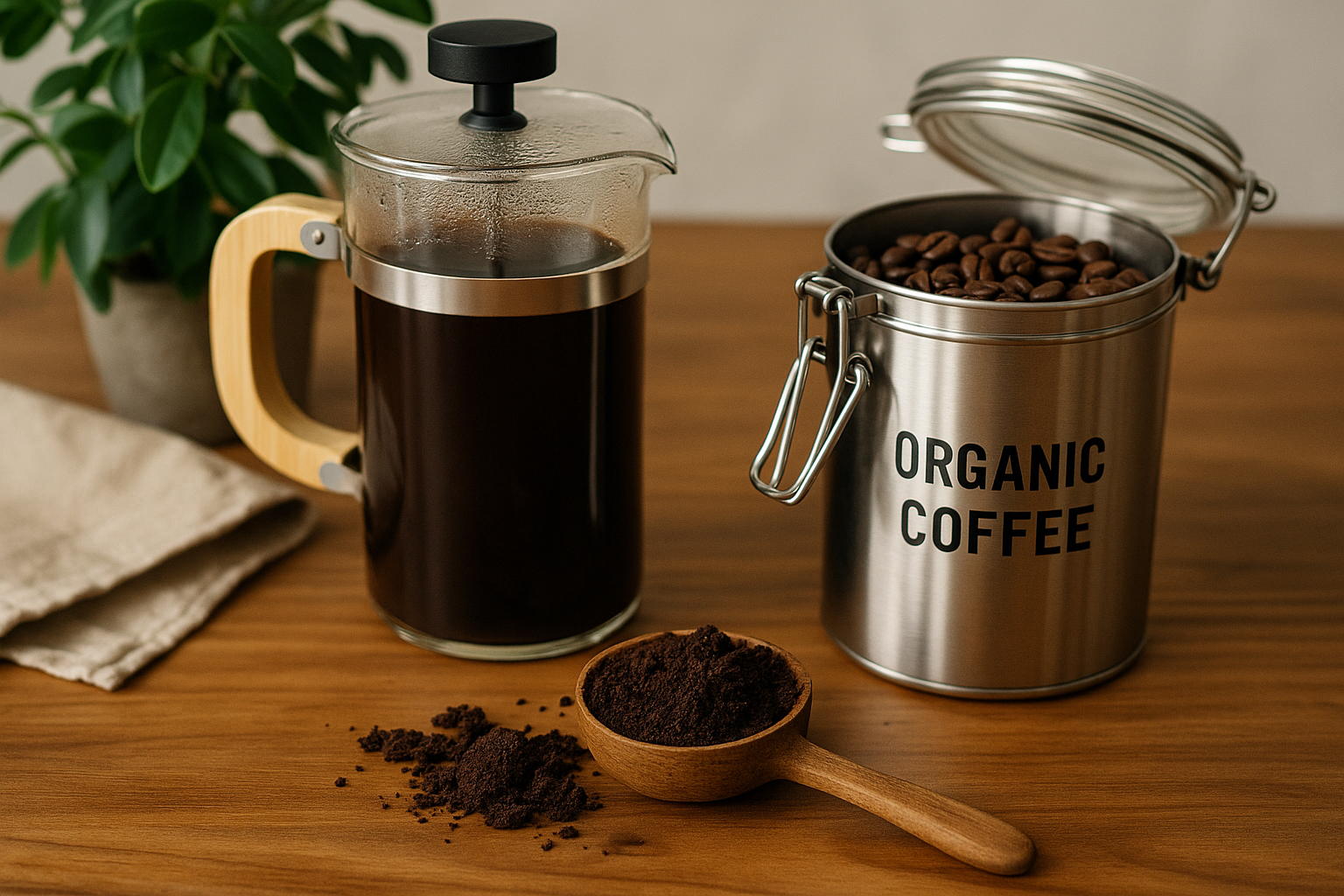Millions of people start their day with coffee—but that daily ritual can add up to a surprising amount of waste. From single-use pods and disposable filters to packaging and leftover grounds, home brewing can be far from sustainable if done without intention.
Fortunately, you don’t have to give up great coffee to reduce your environmental impact. With a few simple shifts, your morning brew can become part of a more eco-friendly lifestyle. This guide will show you how to reduce waste and sip more sustainably—without compromising flavor or convenience.
Why Coffee Waste Matters
When we talk about coffee waste, we’re referring to more than just used grounds. Consider everything that goes into making a single cup:
- Plastic coffee pods
- Paper filters
- Foil-lined bags
- Milk cartons or single-use creamers
- Stir sticks and sugar packets
- Water and energy consumption
- Grounds sent to landfills
These items, multiplied across households every day, add up to a significant environmental burden. And while commercial cafés contribute their share, home coffee drinkers can have a major impact too—both positive and negative.
Step 1: Choose Reusable Brewing Gear
One of the easiest ways to cut coffee waste is to switch from disposable items to reusable alternatives.
Here are some swaps to consider:
- Metal or cloth filters: Replace paper filters in pour-over or drip machines with stainless steel mesh or washable cloth filters.
- French press or Aeropress: Both require little to no disposable materials.
- Manual grinders: Reduce energy use and plastic waste from electric or pre-ground options.
- Reusable coffee pods: If you use a pod machine, switch to refillable stainless steel or BPA-free plastic versions.
These tools not only reduce waste but often improve flavor and extraction consistency as well.
Step 2: Buy Coffee in Sustainable Packaging
Most coffee comes in bags lined with plastic or foil, which are hard or impossible to recycle. Look for brands that offer:
- Compostable packaging: Some bags are made from plant-based materials that break down in industrial or even home compost systems.
- Recyclable bags or cans: Aluminum coffee cans or cardboard tubes are easier to repurpose or recycle.
- Bulk options: Buy larger quantities to reduce packaging or refill your own container at zero-waste stores.
Pro tip: Store beans in an airtight glass or stainless-steel container in a cool, dark place to preserve freshness without relying on plastic.
Step 3: Reuse Coffee Grounds Creatively
Don’t toss your used coffee grounds! They still have value and can be used in eco-friendly ways:
- Fertilizer: Sprinkle in your garden or mix into compost.
- Odor absorber: Place in the fridge, shoes, or trash can to neutralize smells.
- Body scrub: Mix with coconut oil and sugar for a natural exfoliant.
- Cleaning scrub: Use to clean pots, pans, or greasy surfaces.
- Bug deterrent: Scatter around outdoor seating areas to deter ants and slugs.
Reusing grounds helps keep organic matter out of landfills, where it would otherwise release methane—a potent greenhouse gas.
Step 4: Eliminate Single-Use Accessories
It’s tempting to reach for convenience items like disposable stirrers, sugar packets, or pre-filled creamers. But they all create unnecessary waste.
Here’s how to phase them out:
- Use a spoon instead of a stir stick
- Measure sugar or spices from a jar instead of single packets
- Switch to plant-based milks in reusable cartons or make your own
- Avoid individually wrapped coffee sachets or instant sticks
These small changes make a big difference over time and are usually cheaper as well.
Step 5: Brew Only What You Need
Overbrewing leads to wasted water, electricity, and leftover coffee that often gets poured down the drain. Make your coffee more efficient by:
- Measuring carefully: Know how many cups you typically drink and brew accordingly.
- Using a scale: Weighing beans and water improves flavor and reduces waste.
- Keeping extra coffee: Pour leftovers into an ice tray and freeze for later iced drinks.
Being mindful of portion sizes is one of the simplest, most overlooked ways to brew more sustainably.
Step 6: Consider Renewable Energy and Water Use
Every appliance uses energy—and depending on your setup, brewing coffee can be more energy-intensive than you think.
Here’s how to reduce your footprint:
- Unplug machines when not in use
- Use manual brewing methods like pour-over or French press
- Heat only the water you need to avoid waste
- Install a water filter to avoid bottled water
- Consider switching to renewable energy sources, such as solar panels for your kitchen
While this step requires more investment, it dramatically increases the eco-friendliness of your entire kitchen, not just your coffee setup.
Step 7: Support Sustainable Coffee Brands
The coffee you buy plays a major role in your overall impact. Choose companies that:
- Use ethical sourcing practices
- Partner with small farms or cooperatives
- Use recyclable or compostable packaging
- Offer carbon-offset programs
- Invest in regenerative agriculture
Look for certifications like Fair Trade, Rainforest Alliance, or Bird-Friendly—just make sure to research what those certifications actually mean in practice.
Step 8: Repurpose Coffee Tools and Packaging
When your coffee gear reaches the end of its life, try to repurpose or recycle it:
- Turn old mugs into planters
- Use empty coffee bags to store garden seeds or small tools
- Reuse containers for dry food storage
- Donate old gear to community kitchens or thrift shops
- Recycle metal grinders, kettles, or filters properly
Getting creative helps extend the lifecycle of every product and reduces demand for new materials.
Step 9: Compost It All
If you’re serious about reducing waste, home composting is the ultimate step. You can compost:
- Coffee grounds
- Paper filters (unbleached)
- Coffee chaff (from home roasting)
- Certain compostable bags
- Vegetable milk residue
Whether you use a backyard compost bin or a worm composting system (vermicomposting), adding coffee waste helps balance nitrogen in the mix and improves soil fertility.
Step 10: Share the Habit
Sustainable habits spread faster when they’re shared. Help others build more eco-conscious coffee routines by:
- Giving eco-friendly coffee gifts like reusable mugs or grinders
- Starting conversations about sourcing or zero-waste brewing
- Sharing your favorite sustainable brands on social media
- Hosting a coffee tasting with local, ethical roasters
Change starts with awareness, and coffee is a relatable, daily entry point into larger sustainability conversations.
Final Thoughts: A Cleaner Cup, One Brew at a Time
Being an eco-conscious coffee drinker doesn’t require a full lifestyle overhaul. It’s about making consistent, thoughtful choices—switching to reusable gear, supporting ethical brands, and reducing waste wherever possible.
When you brew your next cup, take a moment to appreciate not just the aroma or flavor, but the journey it took to get to you—and the responsibility you hold in shaping what comes next.
Because a sustainable future starts in small, everyday rituals. And coffee, thankfully, is one we get to enjoy while doing good.

